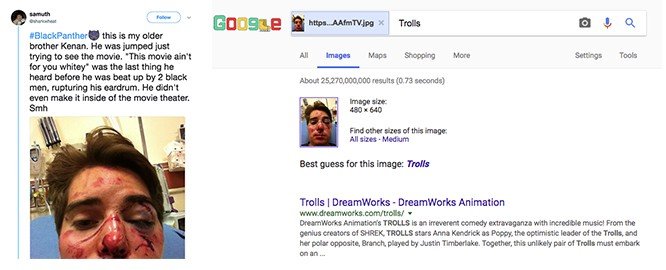Google debuted changes to its image search on February 15th, which simplified the way individual results display. In response to complaints from Getty Images, Google removed some helpful if peripheral features associated with each image found within its results. While this appeased Getty’s copyright concerns, removing these features also meant some simple tools disappeared, which people could use to identify the origin and authenticity of images — tools which could help people identify “fake news” and misinformation.
The timing proved unfortunate. These changes came the same day that internet trolls began distributing photos of white people who had supposedly been attacked by audiences at screenings of Black Panther. Every single tweet was fake. In some cases, people even used images of celebrities or photos from..
recent news stories about domestic abuse to manufacture this misinformation. Of course, these images could be spotted as fake using an image search, but many credulous people helped distribute the images anyway. Obviously, many wanted to believe.

Still, Google’s changes make it more difficult for many users to pinpoint the real origin of images used in fraudulent posts like these quickly. More web savvy folks would no doubt reach for other options such as TinEye or even Google’s image search “Search by image” feature. I’d submit, however, that most users aren’t familiar with these options.
This action belongs in a much broader context, too: February 16th — the day after Google changed its image results — Robert Mueller issued 13 indictments and released a raft of evidence that Russia has been waging a massive misinformation campaign on the internet — a campaign which often utilized manipulated images and memes to disrupt and distress the American conversation. Furthermore, note that after the high school shooting in Parkland, Florida, which left 17 people dead, Russian-linked bots were
immediately deployed to generate hundreds of posts engaging in the ensuing debate over gun control.
Many reports suggested Google simply removed the “View Image” link — which lead directly to an original image — removing it from its context (a tremendously helpful feature itself). Getty complained that this feature enabled people to avoid visiting their site, costing them sales. (The word “piracy” was even employed.) However, Google also removed two other related features. By clicking on a link within the image size (e.g. 800 x 600) previously, you could see a full set of results with those dimensions, allowing you to browse and quickly ascertain when and how widely that image had been used. Beside that feature was a quick link which enabled you to “Search by Image.” It provided you with a much more complete set of results for that image.
Review the following two screen captures to see how these three features were removed:

This screenshot includes the previously available features: search by size, image and view image

An image search on “Edward Hopper” shows the much-simplified features associated with each result
Note that the “Related images” feature remains there, which certainly may enable users to review similar images. That could be helpful in determining the authenticity and real origin of more common images if they’re used by hoaxers in their posts. But results there tend to vary wildly, depending on the image.
As humans, we depend on pattern recognition to help us identify everything in the real world. As a result, we also depend on refining our ability to determine whether objects and content we encounter reflect reality, whether they simply reinforce what we want to believe, or whether we’re being hoodwinked by parties attempting to alter our sense of reality.
In this episode of The Daily podcast discussing Russia’s use of Facebook to spread propaganda, the Times’ technology columnist Kevin Roose concluded his thoughts with the following:
How do you connect a species over the internet without sewing more division and more disunity? … I don’t know whether it’s possible that we’re not really supposed to be all connected in this very easy and seamless way, whether we’re not supposed to able to send things careening around the world with one click.
Seems a fair point given the development of our attention spans from an evolutionary perspective. Consider how — suddenly in the scheme of things — we’ve been confronted with an unimaginable torrent of information. But a decreased flow of information seems unlikely anytime soon. Instead, teaching the public to be more skeptical of the content they’re reviewing and providing them with simple tools to find the facts becomes immeasurably important.
Yet Google just made it harder.

Google may disagree. Upon releasing these changes, the Google Search Liaison account tweeted that “Reverse image search still works through the way most people use it, from the search bar of Google Images.” But do most Google users know about Google Images, a separate instance of search, they’d need to know about to visit?
To be fair, Google still offers an excellent feature, which users can use to identify images on Twitter: Right-click on any image within your Chrome browser and you’ll see the option to “Search Google for image.” However, if you use this link, you’ll be taken to a set of results, which does not provide the same context as the more detailed image search results shown above.

Hoax tweet and the “Search Google Image” result
Consider the example above, which uses one of the Black Panther hoax tweets. Selecting “Search Google for image” on the image in the tweet at left provides the results at right. We can laugh at the associated “Trolls” content, but that wouldn’t appear there before the image was identified in various articles as the work of a troll. And it doesn’t help you determine the true origin of the image.

Scroll further down and you’re shown a selection of “Visually similar images.” But none of these relate directly to the image above, so they don’t help you determine its origin either. You’d have to click on the “All sizes” or “Medium” links to the right of the image to get a complete set of results.
Also the “Search Google for image” feature is browser dependent. Internet Explorer, Safari, and Firefox don’t offer image search upon right-click. You can be sure many — perhaps most — users aren’t aware of the feature, either. And the option isn’t always there. It depends on how the image is embedded.
What are some solutions then?
It’s not difficult to imagine better image search tools. Imagine right-clicking an image and selecting “find original image.” Or “find first use of image.” Google could even improve the flow of its current image search feature, so that if you right-click and select “Search Google images,” your results present that image within a much more informative context and offer features with far greater utility. For example, each result could show or link to the “oldest” instance of this image — functionality TinEye provides — which would immediately reveal that you’re not viewing the image in its true, original context. You’d get that with one click anywhere on the Internet.
Within days of Google’s changes, some enterprising individuals created Chrome extensions, which returned those image search features, though — again — the average user is likely not aware of them. One extension is called, um, “Make Google Image Search Great Again” and it’s available for Chrome and Firefox. There’s also “View Image” for Chrome or Firefox. And there’s “Bring Google View Image Back” for Chrome.
Within the search engine arena, the oft-maligned Bing and privacy-friendly Duck Duck Go still include a similar “View image” feature. Which brings us back to the copyright issue.
Knowing copyright can be used as a wedge to pressure companies to remove features like these, it seems now more than ever we users need to push back. Finding an image online should not be construed as using that image and ignoring its copyright value. In fact, on February 14th Boing Boing won a court case in which Playboy attempted to sue them for copyright because they linked to a now deleted Imgur post featuring, well, every Playboy centerfold ever. The court rightly rejected Playboy’s complaint, confirming the internet’s ability to do what it was intended to do: Link to stuff. The fact that this ruling came the day before Google removed their image search features proves rather ironic, especially given we’re in the middle of what we might call a “fake news” or misinformation war.
Google, Twitter, Facebook and friends, we need more, not fewer simple tools to defend ourselves in this war. In the meantime, maybe it’s on those of us who are aware of these simple tools and ideas to share them. Widely.
I focus on Google here because so many people use their search engine. I don’t think they’re actively trying to prevent people from uncovering misinformation, and I will grant that they do offer helpful features in revealing it. However, these tools just got pushed further away from users’ fingertips. And even from their field of view. Let’s bring them closer.
Hi! I am a robot. I just upvoted you! I found similar content that readers might be interested in:
https://medium.com/s/story/google-just-made-it-harder-to-spot-fake-news-39a1ecff4c40
Good article. New ways to trust but verify. It has been harder to weed out the truth from the fake news.